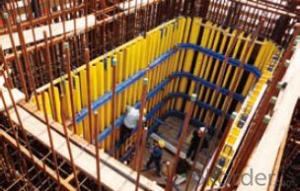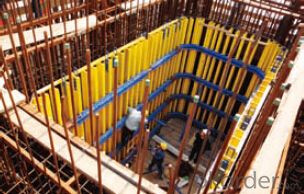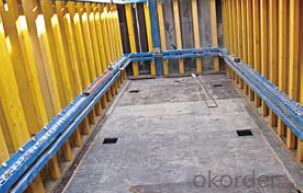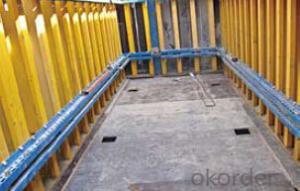Shaft-Platform System for Formwork and Scaffolding
- Loading Port:
- Tianjin
- Payment Terms:
- TT OR LC
- Min Order Qty:
- 50 m²
- Supply Capability:
- 1000 m²/month
OKorder Service Pledge
Quality Product, Order Online Tracking, Timely Delivery
OKorder Financial Service
Credit Rating, Credit Services, Credit Purchasing
You Might Also Like
Shaft Platform
As operating platform, the shaft platform is mainly used in the concrete pouring of elevator shaft,
equipment shaft, stair shaft of high-rise building and so on.
Characteristics:
◆ The length of shaft beam is adjustable.
◆ Flexible structure makes lifting easier.
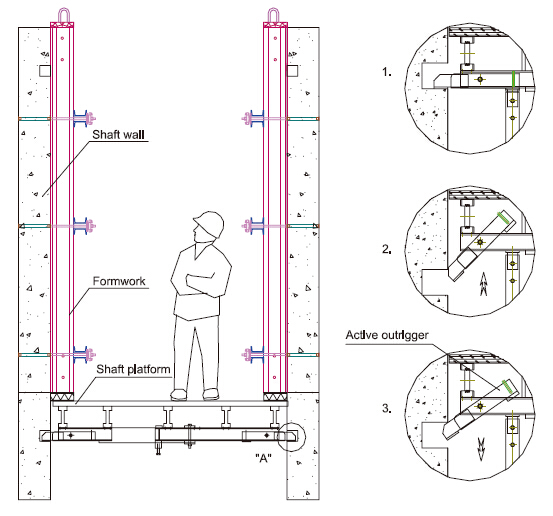
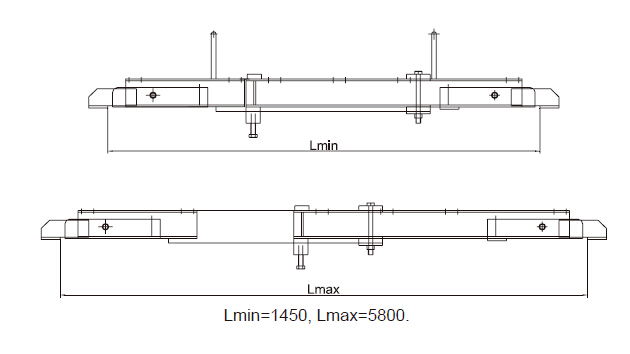
- Q: How does steel formwork affect the quality of concrete?
- Steel formwork can have a significant impact on the quality of concrete in several ways. Firstly, steel formwork provides a rigid and stable structure that holds the concrete in place during the pouring and curing process. This ensures that the concrete maintains its desired shape and form, preventing any distortion or deformation. Secondly, steel formwork allows for precise and accurate construction of concrete structures. The smooth and even surface of steel formwork helps to create a uniform finish on the concrete, reducing the likelihood of surface imperfections such as air bubbles, honeycombing, or unevenness. This results in a higher quality and more aesthetically pleasing concrete finish. Furthermore, steel formwork offers better dimensional stability compared to other types of formwork materials. It is less susceptible to expansion or contraction due to temperature changes or moisture absorption, which can cause cracks or distortions in the concrete. This ensures that the structural integrity of the concrete remains intact, enhancing its overall quality and durability. Additionally, steel formwork provides excellent strength and load-bearing capacity. This allows for the construction of larger and more complex concrete structures with higher structural integrity. The sturdy nature of steel formwork ensures that the concrete can withstand heavy loads and external forces, reducing the risk of structural failures or collapses. Moreover, steel formwork is reusable, making it a cost-effective option in the long run. This not only contributes to sustainability but also ensures consistent quality in concrete construction. The ability to reuse steel formwork reduces the risk of formwork failure or deterioration that could affect the quality of subsequent concrete pours. In conclusion, steel formwork plays a crucial role in enhancing the quality of concrete. It provides stability, precision, dimensional stability, strength, and reusability, all of which contribute to the overall quality and durability of concrete structures.
- Q: What is the maximum load that steel formwork can support?
- The maximum load that can be supported by steel formwork relies on various factors, including the thickness and quality of the steel, the formwork's structural design and configuration, and the supporting structure to which it is attached. Typically, steel formwork is built to endure substantial loads and is commonly employed in high-rise construction ventures. Nevertheless, it is crucial to review the manufacturer's specifications and engineering calculations to ascertain the precise maximum load capacity for a specific steel formwork system. Moreover, the maximum load capacity can also be influenced by the type of concrete poured, the duration of the load, and any dynamic forces that may arise during construction. To ensure safety and the structural soundness of the project, it is advisable to consult a qualified engineer or structural designer who can evaluate the specific requirements of the construction undertaking and provide accurate load capacity information regarding the steel formwork being utilized.
- Q: PVC building template introduction
- VC building templatesPVC building template is also called wood plastic formwork, plastic formwork, plastic formwork. PVC building template is an energy-saving and environment-friendly products, after the wooden template, composite steel formwork, bamboo plywood, all steel template and a new type of product.
- Q: Can steel formwork be used for structures with high chemical resistance requirements?
- No, steel formwork is not suitable for structures with high chemical resistance requirements as steel is prone to corrosion and may react with chemicals, compromising the integrity of the structure. Alternative materials, such as chemically resistant plastics or specialized coatings, would be more appropriate in such cases.
- Q: Can steel formwork be used for residential construction projects?
- Residential construction projects can indeed utilize steel formwork. This option, known for its versatility and durability, presents several advantages in the realm of residential construction. It furnishes a solid and steady framework for the pouring of concrete, guaranteeing accurate and uniform shapes for walls, slabs, and other structural elements. Steel formwork proves to be highly reusable, rendering it an economical selection for residential endeavors with multiple concrete pours. It endures numerous uses and can be effortlessly assembled and disassembled, thereby expediting the construction process and reducing labor costs. Furthermore, steel formwork delivers exceptional dimensional stability, ensuring the final structure possesses precise dimensions and smooth finishes. It can withstand the pressure exerted by wet concrete, enabling the construction of high-rise buildings or structures bearing heavy loads. Moreover, steel formwork permits design flexibility, granting architects and builders the ability to fashion unique and intricate shapes within residential edifices. This adaptability renders it suitable for a diverse array of architectural styles and designs. While the initial investment for steel formwork may be higher compared to other formwork materials, its prolonged lifespan and reusability make it an economically viable solution in the long term. It also demands less maintenance and repair when contrasted with traditional timber formwork. In conclusion, steel formwork represents a fitting option for residential construction projects due to its strength, durability, reusability, dimensional stability, and design flexibility. It bestows numerous benefits and aids in the successful completion of top-quality residential structures.
- Q: What are the considerations when designing steel formwork for high-rise buildings?
- When designing steel formwork for high-rise buildings, several important considerations need to be taken into account. Firstly, the structural integrity and load-bearing capacity of the formwork must be carefully evaluated to ensure it can withstand the weight and forces exerted by wet concrete during the construction process. Secondly, the formwork should be designed with flexibility and adjustability in mind to accommodate various floor plans and architectural designs. Additionally, safety measures, such as incorporating guardrails and non-slip surfaces, should be implemented to protect workers during the construction process. Lastly, the efficiency and ease of assembly, disassembly, and reusability of the formwork should also be considered to optimize construction timelines and cost-effectiveness.
- Q: Can steel formwork be used for structures with high wind resistance requirements?
- Yes, steel formwork can be used for structures with high wind resistance requirements. Steel is a strong and durable material that can withstand the forces exerted by high winds. When used as formwork, steel provides a stable and rigid framework for pouring concrete, ensuring that the structure maintains its shape and integrity even under extreme wind conditions. Additionally, steel formwork can be designed and reinforced to meet specific wind load requirements, making it suitable for constructing buildings in areas prone to high winds or hurricanes.
- Q: Can steel formwork be used for both interior and exterior applications?
- Indeed, steel formwork finds application in both interior and exterior projects. Its durability, strength, and ability to withstand weather conditions make it ideal for diverse construction endeavors. Commonly employed for building walls, columns, slabs, beams, and other structural components, steel formwork furnishes a stable and rigid framework for pouring concrete, guaranteeing the precision and excellence of the ultimate construction. Furthermore, its reusability renders it a cost-effective option for both interior and exterior applications.
- Q: Can steel formwork be used for circular columns?
- Certainly, circular columns can be constructed using steel formwork. Steel formwork possesses great versatility and can be conveniently molded into different shapes and sizes, including circular structures. Its exceptional strength and durability make it ideal for projects requiring formwork that can withstand substantial loads and frequent utilization. Moreover, steel formwork can be easily modified and utilized repeatedly, resulting in cost-effective circular column construction. Typically, the steel formwork is meticulously designed and produced to perfectly align with the precise dimensions and radius of the circular column, guaranteeing an exact and precise formwork system.
- Q: Can steel formwork be used for both slab and column construction?
- Yes, steel formwork can be used for both slab and column construction. Steel formwork is versatile and durable, making it suitable for various types of concrete structures such as slabs and columns. It provides a strong and stable framework that can withstand the pressure and weight of the concrete during pouring and curing processes. Additionally, steel formwork is reusable, making it a cost-effective option for construction projects.
Send your message to us
Shaft-Platform System for Formwork and Scaffolding
- Loading Port:
- Tianjin
- Payment Terms:
- TT OR LC
- Min Order Qty:
- 50 m²
- Supply Capability:
- 1000 m²/month
OKorder Service Pledge
Quality Product, Order Online Tracking, Timely Delivery
OKorder Financial Service
Credit Rating, Credit Services, Credit Purchasing
Similar products
Hot products
Hot Searches
Related keywords
